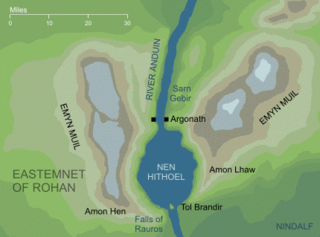Introduction: The Two Towers

When we cracked open the covers of The Fellowship of the Ring, we began the journey. That journey continues with The Two Towers. Now, however, the story is split. Tolkien decided on a unique way of telling this phase of the story. As
 the Fellowship is broken, so are the story threads. And they will not come back together until all the surviving members of the Fellowship are reunited at the end. If you look at this map, you can see the Falls of Rauros at the base of Nen Hithoel, the lake where they parked the boats. On the eastern side of the lake, we follow Frodo and Sam's approach to Mordor and on the western side we follow Aragorn, Gimli and Legolas as they track Merry and Pippin.
the Fellowship is broken, so are the story threads. And they will not come back together until all the surviving members of the Fellowship are reunited at the end. If you look at this map, you can see the Falls of Rauros at the base of Nen Hithoel, the lake where they parked the boats. On the eastern side of the lake, we follow Frodo and Sam's approach to Mordor and on the western side we follow Aragorn, Gimli and Legolas as they track Merry and Pippin.When Tolkien published this second volume at the end of 1954, it was no doubt that the continued journey of the Ring was the most anticipated part of the story as readers already surmised the danger that Frodo and Sam were approaching. For this reason, it is easy to understand why Tolkien would save it for the second part of the book. Also, the tension of not knowing the fate of Frodo and Sam heightened the suspense of the events that unfolded in the "western" story. The reader knows that if the Ring were to fall into Sauron's hands then everything else would be for naught. He experiences the same uncertainty as Aragorn, Theoden, Gandalf and even Saruman. Phillipa Boyens, one of the writers of PJ's films, notes in one of the DVD documentaries that by leaving the "eastern" story for last readers were highly motivated to get there. But Tolkien also had avoided the "eastern" story at first as he had the "western" more fully developed in his mind. He notes in the Foreward to the Second Edition that he continued as far as Chapter 3 of Book V, "and there as the beacons flared in Anorien and Theoden came to Harrowdale I stopped." Christopher Tolkien marks this point as the end of 1942 and it wasn't until 1944 that his father began again, returning to the Frodo and Sam story in Mordor.
For new readers who saw the films first, this format must seem a little confusing (if not frustrating) but it's important to note that by arranging the story this way, the reader is able to stay focused on one part of the story at a time. If you think of how many new people and places that Tolkien introduces in Book III, you can appreciate why he might want your complete attention before he cuts back to Frodo and Sam. It does help one better appreciate the story, however, by having a sense of the big picture. So first I will cover the material in Book III. Then as I write about the journey of Frodo and Sam, I will include in each post a summary of the events from the other parts as they match chronologically with that chapter. I plan to continue this little extra item for The Return of the King as well, until all of the story threads are woven back together.
Now we begin with The Departure Of Boromir...
(revised 9/11/06)


2 Comments:
And he's back! Yes!
Welcome back.
Terry LaForest Lynch
Post a Comment
<< Home